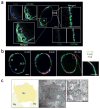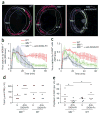Capture of influenza by medullary dendritic cells via SIGN-R1 is essential for humoral immunity in draining lymph nodes
- PMID: 20305659
- PMCID: PMC3424101
- DOI: 10.1038/ni.1856
Capture of influenza by medullary dendritic cells via SIGN-R1 is essential for humoral immunity in draining lymph nodes
Abstract
A major pathway for B cell acquisition of lymph-borne particulate antigens relies on antigen capture by subcapsular sinus macrophages of the lymph node. Here we tested whether this mechanism is also important for humoral immunity to inactivated influenza virus. By multiple approaches, including multiphoton intravital imaging, we found that antigen capture by sinus-lining macrophages was important for limiting the systemic spread of virus but not for the generation of influenza-specific humoral immunity. Instead, we found that dendritic cells residing in the lymph node medulla use the lectin receptor SIGN-R1 to capture lymph-borne influenza virus and promote humoral immunity. Thus, our results have important implications for the generation of durable humoral immunity to viral pathogens through vaccination.
Conflict of interest statement
The authors declare no competing financial interests.
Figures






Similar articles
-
Glycans from avian influenza virus are recognized by chicken dendritic cells and are targets for the humoral immune response in chicken.Mol Immunol. 2013 Dec;56(4):452-62. doi: 10.1016/j.molimm.2013.06.007. Epub 2013 Aug 1. Mol Immunol. 2013. PMID: 23911401
-
Macrophage Death following Influenza Vaccination Initiates the Inflammatory Response that Promotes Dendritic Cell Function in the Draining Lymph Node.Cell Rep. 2017 Mar 7;18(10):2427-2440. doi: 10.1016/j.celrep.2017.02.026. Cell Rep. 2017. PMID: 28273457
-
Dendritic cell-specific intercellular adhesion molecule 3-grabbing nonintegrin/CD209 is abundant on macrophages in the normal human lymph node and is not required for dendritic cell stimulation of the mixed leukocyte reaction.J Immunol. 2005 Oct 1;175(7):4265-73. doi: 10.4049/jimmunol.175.7.4265. J Immunol. 2005. PMID: 16177066 Free PMC article.
-
DC-SIGN, DC-SIGNR and LSECtin: C-type lectins for infection.Int Rev Immunol. 2014 Jan;33(1):54-66. doi: 10.3109/08830185.2013.834897. Epub 2013 Oct 24. Int Rev Immunol. 2014. PMID: 24156700 Review.
-
A fatal attraction: Mycobacterium tuberculosis and HIV-1 target DC-SIGN to escape immune surveillance.Trends Mol Med. 2003 Apr;9(4):153-9. doi: 10.1016/s1471-4914(03)00027-3. Trends Mol Med. 2003. PMID: 12727141 Review.
Cited by
-
Combined PET and whole-tissue imaging of lymphatic-targeting vaccines in non-human primates.Biomaterials. 2021 Aug;275:120868. doi: 10.1016/j.biomaterials.2021.120868. Epub 2021 May 14. Biomaterials. 2021. PMID: 34091299 Free PMC article.
-
Moving to the suburbs: T-cell positioning within lymph nodes during activation and memory.Immunol Cell Biol. 2015 Apr;93(4):330-6. doi: 10.1038/icb.2015.29. Epub 2015 Mar 10. Immunol Cell Biol. 2015. PMID: 25753266 Review.
-
Structural and functional evaluation of de novo-designed, two-component nanoparticle carriers for HIV Env trimer immunogens.PLoS Pathog. 2020 Aug 11;16(8):e1008665. doi: 10.1371/journal.ppat.1008665. eCollection 2020 Aug. PLoS Pathog. 2020. PMID: 32780770 Free PMC article.
-
Cell receptors for influenza a viruses and the innate immune response.Front Microbiol. 2012 Mar 28;3:117. doi: 10.3389/fmicb.2012.00117. eCollection 2012. Front Microbiol. 2012. PMID: 22536196 Free PMC article.
-
Plitidepsin as an Immunomodulator against Respiratory Viral Infections.J Immunol. 2024 Apr 15;212(8):1307-1318. doi: 10.4049/jimmunol.2300426. J Immunol. 2024. PMID: 38416036
References
-
- Pulendran B, Ahmed R. Translating innate immunity into immunological memory: implications for vaccine development. Cell. 2006;124:849–863. - PubMed
-
- Gerhard W, Mozdzanowska K, Furchner M, Washko G, Maiese K. Role of the B-cell response in recovery of mice from primary influenza virus infection. Immunol Rev. 1997;159:95–103. - PubMed
-
- Gretz JE, Anderson AO, Shaw S. Cords, channels, corridors and conduits: critical architectural elements facilitating cell interactions in the lymph node cortex. Immunol Rev. 1997;156:11–24. - PubMed
Publication types
MeSH terms
Substances
Grants and funding
LinkOut - more resources
Full Text Sources
Other Literature Sources
Molecular Biology Databases

